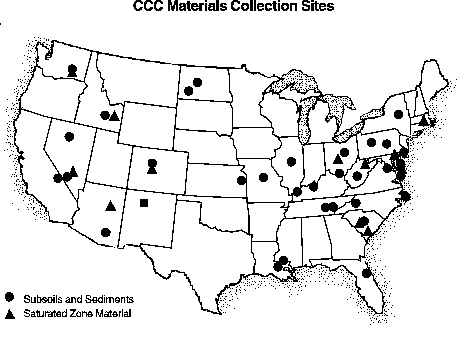Subsurface Materials Available for NABIR Research
OBER, through its Subsurface Science Program, has established a collection of subsurface materials for use in hypothesis-driven research on vadose zone and groundwater biogeochemistry and in support of remediation activities at DOE sites. The collection was assembled to meet two objectives: (1) to span important physical, chemical, and mineralogic properties controlling contaminant reaction and distribution and microbially mediated phenomena, and (2) to represent site- and formation-specific subsurface conditions at key DOE facilities.

The materials were obtained from DOE lands and other locations nationally (Figure 1) and include:
- Bulk samples of subsoil and near-surface subsurface materials collected from outcrops, sand pits (including Oyster, VA), and deep trenches
- Core samples of deep subsurface materials (vadose zones, aquifers, aquitards) obtained from select DOE sites (Hanford, Idaho National Engineering Laboratory, Savannah River) as part of deep microbiological research
- Surface soils (including distinct horizons from individual soil profiles) representative of most facilities in the DOE weapons complex
Subsets of materials have been assembled within the collection that vary systematically in key properties and that are relevant to the subsurface biogeochemistry of metals and radionuclides. (See examples in Table 1: Descriptive Characteristics of a Series of Subsurface Sediments that Contain Fe-oxides; and Table 2: Characteristics of a Series of Materials with Mineralogy Dominated by Layer Silicates.) Such properties include but are not limited to: pH and surface area; mass fraction of organic matter; Fe(III)-oxide mass content and crystalline form/mineralogy; type, morphology, and charge density of layer silicates; and mass content of Al and Mn(IV) oxides. Other sequences involving nutrients or intrinsic electyron acceptors are possible that are relevant to bioremediation, e.g., total phosphate content.
The collection functions as a common source of DOE-relevant subsurface materials and as a repository of characterization data that may be accessed and used by other investigators to facilitate their research. The materials vary in their availability depending on whether they are synthetic or were collected from accessible (e.g., borrow pit) or inaccessible (e.g., deep aquifer or aquitard zones) locations. Requests for bulk samples of some materials require resampling of field sites. An example of the nature selected materials present in the collection and representative descriptions and characterization measurements for them is given in the two attached tables.
Information on the materials collection may be obtained from Dr. F. J. Wobber, OBER (Frank.Wobber@science.doe.gov) or Dr. J. M. Zachara, PNNL.

